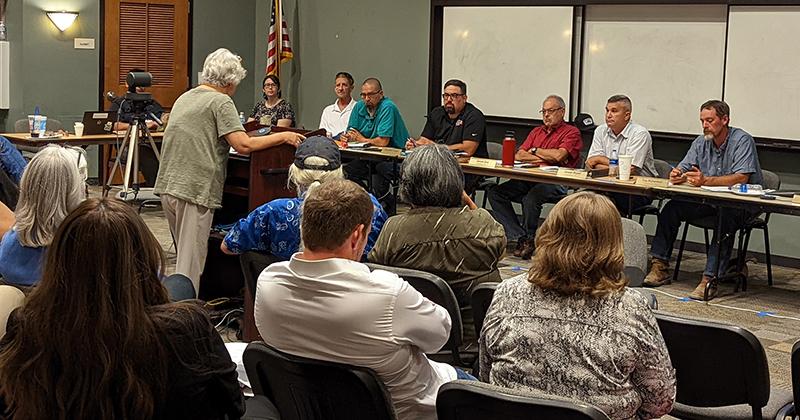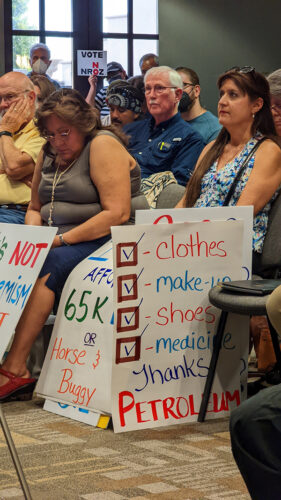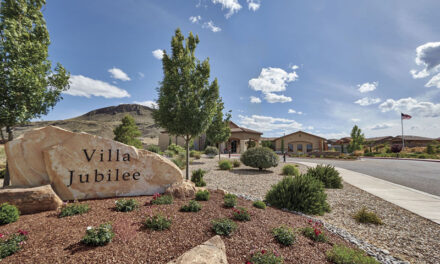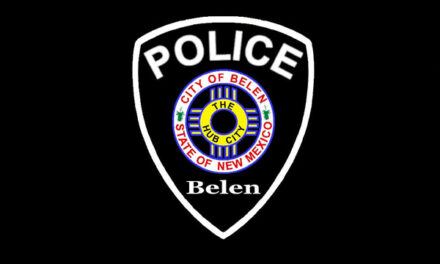After hearing from the public for more than seven hours, Valencia County commissioners approved a controversial overlay zone on a 3-2 post-midnight vote.
The public hearing for a natural resource overlay zone started shortly after 5 p.m., Thursday, July 14, with more than 150 people pressed into the auditorium at the Los Lunas Transportation Center, and dozens more standing in the hallway, spilling out into the courtyard.
The overlay zone allows for the extraction of natural resources from a piece of property — everything from brackish water to gravel to oil and natural gas — without changing the underlying zoning.
While the NROZ applies to several types of resources, many Valencia County residents concerned with environmental repercussions honed in on oil drilling, and specifically hydraulic fracturing — fracking.
Clara Simms, a Los Lunas resident, urged the commission to reject the NROZ, saying it made it far too easy for the oil and gas industry to come to Valencia County.
“We will become another sacrifice zone,” Simms said. “All this economic development in the community has moral and ethical implications. I hope you understand the gravity of the decisions made here today.”

Julia M. Dendinger | News-Bulletin photo
Duana Draszkiewicz, a member of Valencia Water Watchers, was one of more than 30 people who spoke out against the natural resource overlay zone in Valencia County. The ordinance passed on a 3-2 vote and will be used in the unincorporated areas to explore and extract natural resources such as gravel, aggregate, oil and natural gas.
While more than 30 people spoke out against the NROZ, about a dozen supported the proposed ordinance.
Valencia County resident Albert Shrecengost said the overlay was a way for someone to approach the county.
“This is a way for someone who has a need to come to Valencia County and talk to you about a way to get what they want done,” Shrecengost told the commissioners. “You’ve been asked to adopt this. It doesn’t give anybody a green light to do anything.”
To obtain an NROZ on a piece of property, an applicant has to go before the county’s planning and zoning commission at a public hearing to present the project. The P&Z commission will make a recommendation of either approval or denial to the county commission, which then holds a second public hearing before voting on the application. The public is allowed to offer input and testimony during both public hearings.
The New Mexico Department of Energy, Minerals and Natural Resources’ oil control division also has to issue a drilling permit to an applicant before exploration or extraction can begin.
During the public hearing, several members of the public pointed out the county already has a mineral resource zoning option, which allows for drilling and extraction containing what they felt were more stringent safety controls as opposed to the NROZ.
Valencia County Commission Chairman Gerard Saiz asked county attorney Dave Pato how many MR zone change requests had been brought to the commission in recent years.
The attorney said in the 15 years he’s been with the county, none came to mind.

Julia M. Dendinger | News-Bulletin photo
New Mexico oil developer and Valencia County property owner Harvey Yates listens to the testimony offered to the Valencia County commission about the controversial Natural Resources Overlay Zone, a zoning ordinance change he requested.
“With the greenhouse and solar overlays, there was some demand,” Saiz said of similar ordinances. “If in 15 years we’ve not had some kind of mineral resource zone request, I don’t see the purpose of this.”
When Saiz called for a motion on the ordinance, there was a prolonged silence from the commissioners. Eventually, Commissioner Jhonathan Aragon made a motion to approve the NROZ with additional safeguards added from the existing MR zoning designation. Commissioner Troy Richardson made the second.
Some of the amendments to the NROZ include the requirement of an analysis of existing site conditions, which includes the location of existing and proposed structures within 500 feet of the extraction site, a generalized project development timetable and evidence to demonstrate the presence of oil, natural gas (and other resources) of sufficient quantity and quality to justify the granting of the NROZ.
The amendments also included front, rear and side yard building setbacks, which stipulates the distance exploration and extraction wells must be from the outer boundary of the property — 1,000 feet, surface water or a well, a public road and an existing residence — 500 feet.
Oil and gas developer Harvey Yates, the Valencia County property owner who brought the idea of the overlay zone to the county, said Friday morning he hadn’t seen the final version of the NROZ with the amendments.
“Last night, I sat there trying to hear what the amendments were. I’m still waiting,” Yates said when asked what his next steps would be. “I need to see the changes to the overlay zone before I decide.”
Aragon, Richardson and Commissioner Joseph Bizzell voted in favor, while Saiz and Commissioner David Hyder voted against the new ordinance.
Natural Resource Overlay Zone
(Amendments highlighted in blue)
NM Oil Conservation Division Overview
Julia M. Dendinger began working at the VCNB in 2006. She covers Valencia County government, Belen Consolidated Schools and the village of Bosque Farms. She is a member of the Society of Professional Journalists Rio Grande chapter’s board of directors.

















